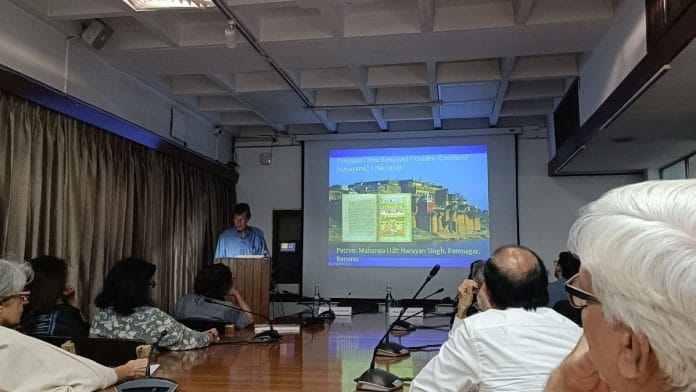New Delhi: The crow served as an unlikely symbol of radicalism in Tulsidas’ epic poem, Ramcharitamanas. Scholar Philip Lutgendorf’s argument during his talk at the India International Centre earlier this month was based on this, bringing a unique perspective to the centuries-old text by Awadhi poet Tulsidas.
With pictures from the Kanchana Chitra Ramayana, references to Valmiki’s Ramayana, and even audio recordings of crow voices, Lutgendorf painted a vivid picture of the 16th-century retelling of the Ramayana and of his own argument regarding it—that the crow Bhushundi is an alter-ego of Tulsidas himself.
The Emeritus Professor of Hindi and Modern Indian Studies at the University of Iowa had a rapt audience listening and responding to each of his claims, with many staying on to discuss how KakaBhushundi (the crow Bhushundi), the fourth and final narrator of the Ramcharitamanas, fits into the broader cultural and social landscape of Tulsidas’ time.
“Why would Tulsidas choose a crow – a ‘chandal’ [an outcaste] among birds, as he himself calls it—to narrate the final section of Ramayana?” questioned Lutgendorf, introducing his lecture titled Ending with a Crow: Bhushundi in the Ramcharitmanas of Tulsidas (and Beyond) organised in collaboration with the American Institute of Indian Studies.
Lutgendorf’s argument was at once simple and layered. The Ramcharitmanas had four narrators divided across the seven chapters or ‘kanda’, he explained for those unaware in the audience. These include Tulsidas himself, the sage Yajnavalkya, the god Shiva, and Kakabhushundi, or just Bhushundi.
“The interesting thing to note is that Tulsidas begins the narration, and Bhushundi ends it in the Ramcharitmanas. There is a cyclical nature to the poem,” said Lutgendorf.
But the question remained—why Kakabhushundi when all other narrators were either human or divine in human form? And even within birds why a crow, and not a “more auspicious” bird like a parrot or a koel, pointed out Lutgendorf.
By way of answering his own question, Lutgendorf presented the crux of his lecture, which is that Tulsidas’ choice of the avian narrator was a reflection of his ‘self-perception’. The qualities of Bhushundi that Tulsidas highlights—his utmost devotion for Rama, his preference for sargun (with form) worship over nirgun (formless) worship, and his general disregard for the social stratification in Hindu culture—are all qualities that are attributed to Tulsidas himself.
“The character of Bhushundi is that of a fallen Brahmin in a despised form—mindful yet dismissive of hierarchy, whose only mission is to narrate the story of Rama,” said Lutgendorf. “Doesn’t it resemble another audacious yet opinionated character who narrates the story of Rama to all of us? Bhushundi is a disguised twin of Tulsidas himself.”
Also read: 3 reasons why Hinduism is purging itself of texts promoting casteism—and why I welcome it
A radical choice
The Ramcharitmanas was radical for its time. By writing the poem in the commonly spoken Awadhi, Tulsidas opened up access to the Ramayana to a larger audience than ever before. Earlier renditions of Valmiki’s Ramayana, as the moderator and writer Ananya Vajpeyi explained, had been restricted to the upper echelons of Sanskrit-educated people.
“What Tulsidas did was not looked upon kindly by his Brahmin peers, which might have led him to feel outcast by his own tribe,” argued Lutgendorf. “Bhushundi too was an outcast among birds, and Tulsidas recurringly referred to it in his own text too.”
The evidence for Bhushundi serving as Tulsidas’ alter-ego are numerous, according to Lutgendorf’s talk. Almost two-thirds of the Uttara Kanda, the final chapter of Ramcharitmanas, deals with Bhushundi recounting his own life story to Garuda, another bird character from the Ramayana.
This almost ‘self-serving’ narration encompasses questions and answers about how Bhushundi came about to be Lord Rama’s most devout follower. The Ramcharitmanas also talks about how Bhushundi returns at every age to Rama’s birthplace Ayodhya to watch the young prince grow up.
“If you think about it, Tulsidas is expressing, through Bhushundi, his own love for young Rama,” said Lutgendorf. “Unlike Valmiki’s Ramayana when Rama grows up in five shlokas, Tulsidas spends an entire chapter just on the stories of young Rama.”
Lutgendorf explained that Bhusundi, at the end of the day, embodies the ‘whole-nine-yards’ of Tulsidas who was himself a complex character.
“The most radical thing about Tulsidas’ Ramayana was his form—the language he wrote it in made it accessible but the message remained conservative,” he said. Similarly, Bhushundi’s form of a crow is radical, but Tulsidas also wrote him as someone who used to be a Brahmin, and who also holds up the conservatism that is present in the Ramayana.
Toward the end of the discussion, Lutgendorf brought out another interesting observation about Bhushundi. The Ramcharitmanas is a poem and at times even a song, but Tulsidas chose a cawing crow to narrate it.
“What are the implications of a not-so-melodious bird narrating the melodious epic of Rama?”
(Edited by Theres Sudeep)






